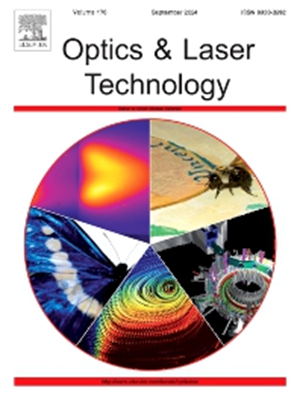Fiber-optic quantum gyroscope based on Hong-Ou-Mandel interferometry
IF 4.6
2区 物理与天体物理
Q1 OPTICS
引用次数: 0
Abstract
Hong-Ou-Mandel (HOM) interferometry with quantum states has emerged a crucial tool for precision measurement system. Here, a novel scheme for angular velocity measurement in a fiber-optic quantum gyroscope is proposed and demonstrated, based on Sagnac effect of frequency-entangled biphotons and incorporating a HOM interferometer. The time delay resulting from the rotation-induced Sagnac effect between the signal and idler photons generates a shift of HOM dip, which is proportional to the angular velocity. Consequently, a highly sensitivity and stability angular velocity measurement is achieved by monitoring the HOM dip. The sensitivity scale is measured to be which is equivalent to a minimally detectable angular velocity of with a time delay of . The measurement stability of the continuous rotating system, in terms of time Allan deviation (TDEV), reaches at an averaging time of 10,240 s. The corresponding angular velocity measurement stability reaches . This scheme holds potential for advancing the development of high-performance optical quantum gyroscopes.
求助全文
约1分钟内获得全文
求助全文
来源期刊
CiteScore
8.50
自引率
10.00%
发文量
1060
审稿时长
3.4 months
期刊介绍:
Optics & Laser Technology aims to provide a vehicle for the publication of a broad range of high quality research and review papers in those fields of scientific and engineering research appertaining to the development and application of the technology of optics and lasers. Papers describing original work in these areas are submitted to rigorous refereeing prior to acceptance for publication.
The scope of Optics & Laser Technology encompasses, but is not restricted to, the following areas:
•development in all types of lasers
•developments in optoelectronic devices and photonics
•developments in new photonics and optical concepts
•developments in conventional optics, optical instruments and components
•techniques of optical metrology, including interferometry and optical fibre sensors
•LIDAR and other non-contact optical measurement techniques, including optical methods in heat and fluid flow
•applications of lasers to materials processing, optical NDT display (including holography) and optical communication
•research and development in the field of laser safety including studies of hazards resulting from the applications of lasers (laser safety, hazards of laser fume)
•developments in optical computing and optical information processing
•developments in new optical materials
•developments in new optical characterization methods and techniques
•developments in quantum optics
•developments in light assisted micro and nanofabrication methods and techniques
•developments in nanophotonics and biophotonics
•developments in imaging processing and systems

 求助内容:
求助内容: 应助结果提醒方式:
应助结果提醒方式:


